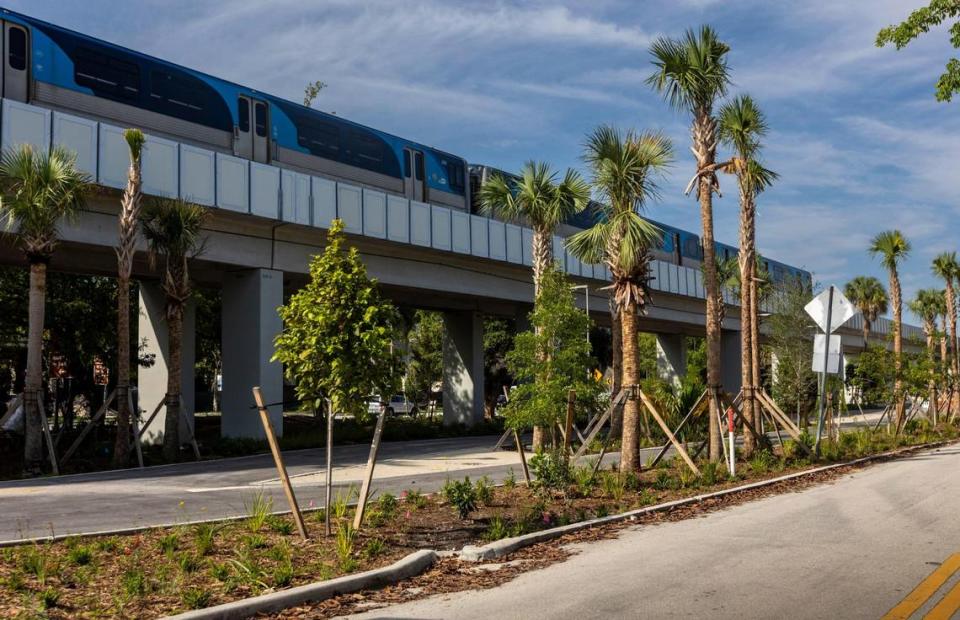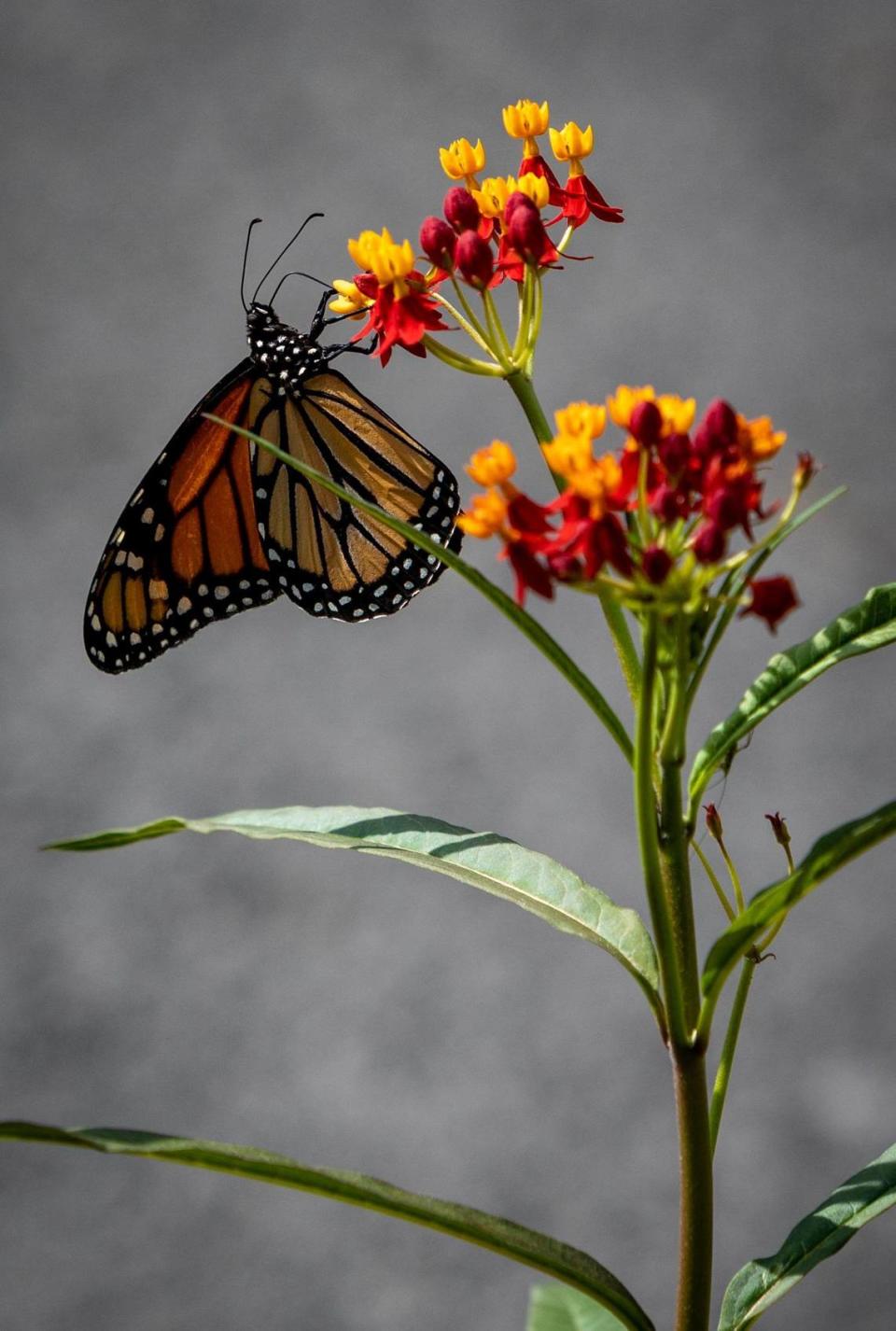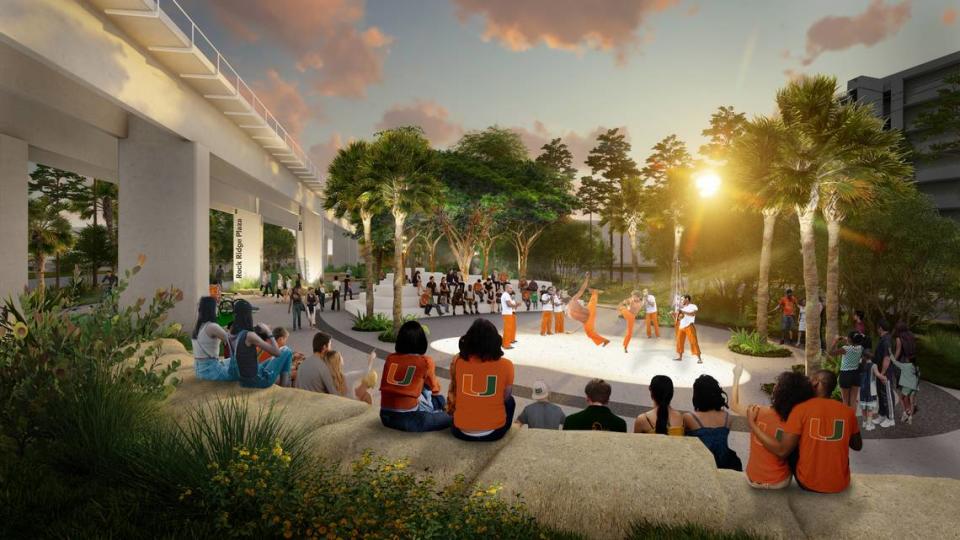Micro-forests, rainwater ponds, pickleball and more: Here comes The Underline’s last phase
An artisan market. A dog park with an agility course for quadrupeds. Outdoor pickleball, a skate park, half-court basketball and a soccer mini-pitch for humans. A tropical garden playground for young kids. Self-sustaining micro-forests. Walkways suspended over botanical rainwater ponds. And, as always, lots of public art.
Those elaborate features, and more, are what’s in newly unveiled plans for the third and final phase of The Underline, the $140 million urban trail and linear park that will soon run for 10 lushly landscaped miles under the elevated Metrorail tracks from the Miami River to the Dadeland South station, the public transit line’s endpoint.
Though subject to refinement before a final reveal in the fall, the extensive phase-three blueprint represents the likely shape of the Underline’s last seven-and-a-third miles, a section stretching from Coconut Grove to Dadeland South along U.S. 1.
At the same time, contractors who have contended with unforeseen obstacles are working to complete the trailblazing project’s delayed second phase, a 2.14-mile segment between Brickell and the northern edge of the Grove, before the end of this year — about five months behind schedule.
Because the two segments are being handled by separate design-build teams, Underline consultants say the third phase has not been affected by second-phase delays, blamed in part on COVID-19 pandemic-related supply issues and a simultaneous Florida Power & Light project to bury transmission lines along the north half of the corridor.

FPL’s project is supposed to wrap up as construction begins on the Underline phase-three section in September, the contractors who secured the competitive bid for the final phase say. They said overall completion remains slated for the end of 2025, a deadline imposed by a federal grant, though some sections of the third section will open for public use sooner.
And while backers say they understand some people who have been eagerly awaiting development of the Underline for years are impatient, they contend the wait for the last bit will be worthwhile.
“They came up with some amazing stuff,” Underline co-founder Meg Daly said of the project’s phase-three designers. “I was blown away.”
Innovation and creativity
The third phase, she noted, will encompass some of the Underline’s most innovative and ambitious design elements, including ponds and bioswales designed to collect and filter rainwater runoff in a garden setting. It will also introduce a novel concept for South Florida — the Miyawaki method — to grow a series of so-called micro-forests from scratch.
Under the Miyawaki approach, developed by a Japanese botanist, a broad variety of native trees and bushes selected for their ability to feed off one another are planted in dense, compact clusters. That allows them to grow 10 times faster than under traditional forestation methods, creating tiny ecosystems that require little maintenance. Underline designers are working with Fairchild Tropical Botanic Garden on the micro-forests, which they say will mimic the coastal hardwood hammock habitats that once covered the upland portion of the local shoreline.
“In 10 years, this will be the way we reforest our city,” Daly said.

Daly credits the cutting-edge ideas to the third-phase team, a co-venture led by construction managers NV2A Group and builder Central Civil, both local firms. Overseeing design for the team is New York-based James Corner Field Operations, the landscape architecture and planning firm best known for co-designing Manhattan’s massively popular High Line. Field Operations is also responsible for the Underline’s overall master plan and design of its first completed half-mile section in Brickell, which opened in early 2021.
Like the Brickell Backyard section and the five connected segments in phase two, the third phase will reintroduce native tree and plant species, including Dade County pine, that once thrived along the corridor, which was created 120 years ago when industrialist Henry Flagler extended his Florida East Coast Railway into Miami atop a coastal limestone ridge. Miami-Dade built the southern half of the elevated Metrorail line, the stretch from downtown Miami to Dadeland, on the abandoned rail corridor in the 1980s.
The county also built the bare-bones, paved M-Path beneath the tracks, but the trail was lightly used. Daly, unable to drive because of two broken elbows she suffered in a bicycle accident, was walking from her Coral Gables home to the nearest Metrorail station a few years ago when she noticed the scruffy path and, inspired by the High Line, came up with the idea for the Underline.
In 2015, she formalized the campaign by founding Friends of The Underline, which succeeded in winning wide-ranging political, civic and corporate support for the project, now fully funded through a combination of municipal, county, state and federal funds as well as private grants. The nonprofit group raises money for development and maintenance of the project while a spinoff, The Underline Conservancy, manages and maintains the trail with private funds. Miami-Dade County is in charge of contracting and construction.
The third segment will bring 1,800 new trees and palms to the trail, expanding the existing tree canopy along that stretch to 3,960 specimens. Nearly 90% of trees and palms already in place will be retained, though some will be moved. The rest will be taken out because they’re in poor health or are invasive species, such as Brazilian pepper, among other factors. New plants and bushes will number around 350,000 specimens.
“We have the opportunity with this project to create a new ecological corridor in the city,” said Isabel Castilla, Field Operations lead Underline designer.

The extensive tree canopy and landscaping will screen trail users from motorized traffic along U.S. 1, provide shade and cool temperatures, and help control inundation from rain, Castilla said. The phase three trail segment will also be interspersed with micro-forests and a series of botanical gardens, some designed to attract butterflies and others to collect rainwater in shallow ponds and gravel-lined swales. Elevated walkways will allow people to cross the ponds and swales, though the water gardens would be wet only when it rains.
The natural elements are meant to complement The Underline’s primary purpose — a transportation project that links Metrorail stations, bus lines, neighborhoods and businesses, and helps build a sense of community by providing appealing, safe spaces for people to gather for fitness and sports, as well as art, culture and food, Daly and Castilla said.
Most of the broad corridor, which runs from 75 feet at its narrowest to as wide as 130 feet, features separate paved paths for people on foot and people on bikes. Bike paths, which are perfectly straight for safety and visibility, are at least 10 feet wide. Walkways, which bend and meander, are a minimum of eight feet. The pathways were painstakingly designed and aligned to require uprooting as few trees as possible along the phase-three route, NV2A vice president Luis Arditi Rocha said.
Improved street crossings
The phase-three plans also provide for significantly improved street crossings — one of the trickiest aspects of the project, which seeks to ensure the safety of walkers, runners and cyclists in the face of 25 intersections, heavy traffic and Miami’s famously oblivious motorists.
Proposals to enhance intersection safety include better sightlines, realigned crossings, better signage and conspicuous pavement markings, and also crossing signals that favor pedestrians and cyclists by giving them a head start of several seconds over cars. At some especially hazardous intersections, such as Red Road, planners are proposing no-right-turn-on-red signs for cars to reduce the chance for collisions with trail users, though those must be approved by state and county transportation officials.

To speed up construction, the third phase — divided up into seven discrete segments — will be built in two stages. First, construction will move forward simultaneously at the south end, as well as at the northernmost segment that connects to phase two at Southwest Nineteenth Avenue. A third segment will be built at the same time between LeJeune Road and Douglas Road.
The four segments in South Miami and Coral Gables, which include some of the novel botanical features and water ponds, then will follow.
But people won’t have to wait until the full third phase is completely done to enjoy it. Segments will be opened for use as they’re finished.
“If it’s completed, it will be opened,” NV2A’s Arditi Rocha said.
Amenity hubs
The 12 amenity hubs along the seven-mile stretch, which runs through six Metrorail stations and across three canals, incorporate elements that people asked for in public meetings last December, including a skate park just north of Red Road in South Miami, as well as a fitness room near the University of Miami in Coral Gables encompassing four pickleball courts, a basketball half-court and a soccer mini-pitch.

Those features aren’t included in current project budgets, but Daly said she’s working to finalize approved state funding that will likely cover the costs. Skate-park petitioners are also raising money on their own, Arditi Rocha said.
If funding isn’t immediately available as construction begins, the plan’s framework makes space for the amenities so they can be easily added later, Arditi Rocha said.
“The team said, what’s the best vision of what we can do here? And then let’s see what we can get,” he said.
The planned amenities include:
▪ The Grove Gallery, a flexible market space that can accommodate local crafts and farmer’s stalls, just north of Southwest 27th Avenue.
▪ The Underline Plaza, a neighborhood gathering spot just south of the Douglas Road metro station, with space for rotating, temporary public art installations, an outdoor lounge and food trucks.
▪ The Bark Park, an elaborate dog run that will replace a public parking lot behind the Life Time Coral Gables apartment and retail complex, which is separately funded by the city of Coral Gables and designed by local firm Savino Miller Design Studio.

▪ Water Balcony and Kayak Launch, one of the more complex activity hubs, which would improve an existing, informal access point to the Coral Gables Waterway at Riviera Drive with a new Underline bridge and observation balcony over the canal, a restored, planted shoreline and, pending funding from Miami-Dade’s parks department, a proper launch for non-motorized watercraft.
▪ The Rock Ridge Plaza, by the University of Miami, a small amphitheater with boulder seating for outdoor performances and classes.
▪ Play Forest, an exploration trail and natural “playscape” for kids in a tropical garden behind South Miami City Hall.
▪ Butterfly Garden, at Dadeland Boulevard just north of the Dadeland South station, the largest of a series of spots along the Underline phase three cultivated with pollinator plants to draw the colorful insects.


